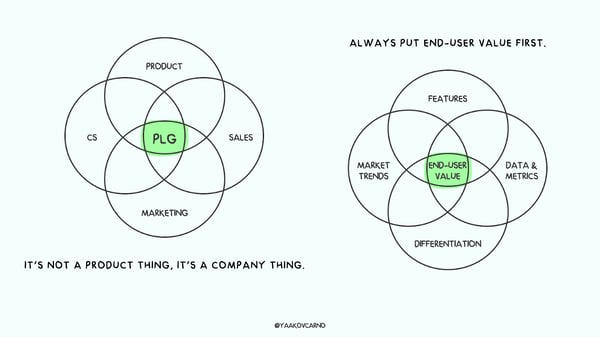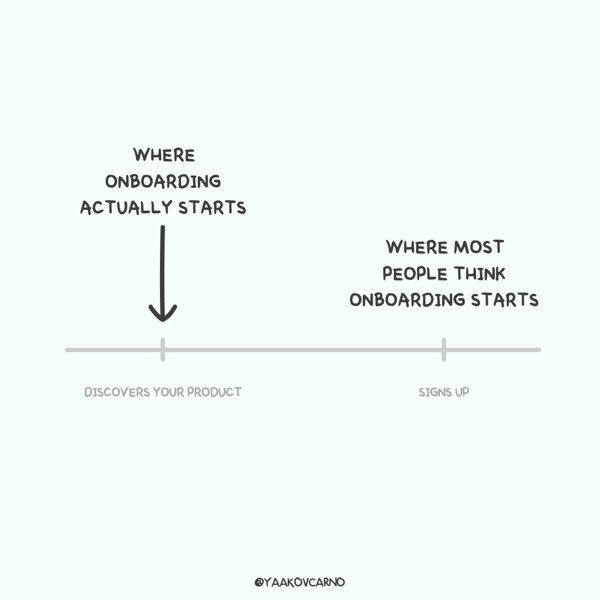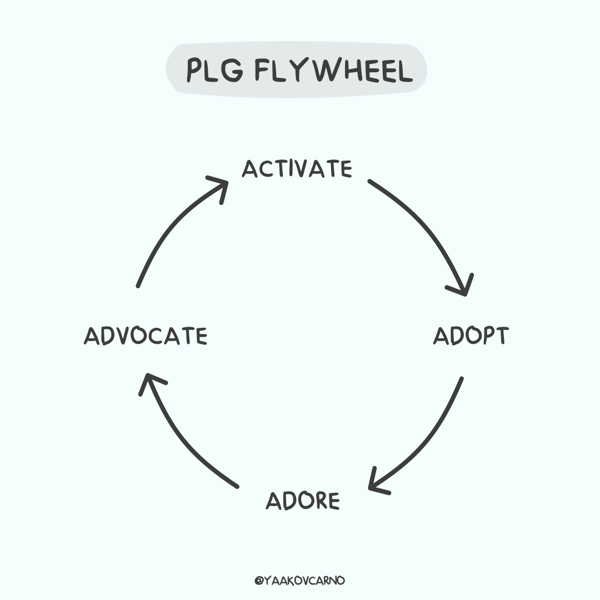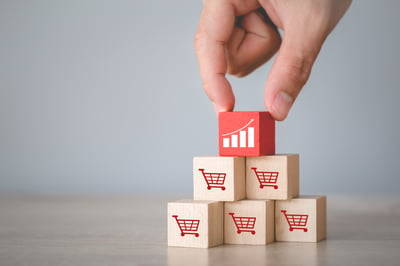May 12, 2023
 by Yaakov Carno / May 12, 2023
by Yaakov Carno / May 12, 2023

In the world of SaaS, a new strategy has emerged that's turning traditional sales models on their heads.
This strategy is called product-led growth (PLG). It’s one of the hottest buzzwords out there right now, but many teams are struggling with how to get it right.
Companies like Atlassian, Notion, and Airtable are experiencing exponential growth, stepping ahead of their competition, and constantly scaling their revenue. These companies, and many more like them, leverage a product-led strategy.
In this article, we’ll explore:
Product-led growth is a strategy that leverages the product itself as the primary driving force of acquisition, retention, expansion, and monetization. A product-led company is a trailblazer in the world of SaaS, disrupting traditional sales models and putting the power in the hands of the user.
An important point to mention here is that PLG is not a product thing, it’s a company thing. Every team and department is part of the process and must work together.
These companies prioritize the creation of a product so valuable and user-friendly that it sells itself. They believe that if they can provide a product that delights users, those users will tell others, resulting in massive growth and virality.
At the core of PLG is a deep understanding that the end-user experience is the most critical factor in driving long-term success.

Product-led growth companies include Canva, Figma, HubSpot, ClickUp, Slack, Calendly, and the list goes on. These all leverage a freemium model and rely heavily on user adoption and virality to drive growth.
These examples also have a powerful onboarding journey that allows users to experience the value of their products almost instantaneously.
Let’s dive into specific examples to demonstrate the concept of PLG.
Plus, they all support the user journey through the PLG flywheel: Activate, Adopt, Adore, Advocate.
PLG companies prioritize user feedback and usage data to constantly evolve, improve their products, and create an incredible customer experience that fuels their flywheel.
Product-led growth practices prioritize the user experience, leading to a more loyal customer base and higher retention rates. This approach also focuses on the product's ability to sell and market itself, heavily reducing sales and marketing costs.
Product-led growth fuels growth loops rather than funnels.
The old pattern was for users to be acquired solely through funnels. They’d discover the product through sales or marketing and then need to go through a product demo or sign a contract before they even experience the product itself. The problem with this model is that it completely relies on top-of-funnel efforts that have higher costs and doesn’t support efficient and scalable long-term growth.
In contrast, product-led loops such as word-of-mouth, user-generated content, and collaborative workspaces all create a system of cyclical usage. This allows the product to market itself and act as an acquisition channel for existing users.
Other benefits include lower customer acquisition costs, powerful feedback loops, shorter sales cycles, and more.
The voice of the customer is critical in the software buyer's journey.
As end-users have become the buyers (or at least key players in the decision-making process) in today’s market, they are more interested than ever in what other users are saying. The voice of the customer provides valuable insights into the product's strengths and weaknesses.
For example, customer reviews offer social proof and provide potential customers with authentic feedback from current users. People trust other people way more than they trust marketing. These reviews can strongly impact the buyer's purchasing decision, making them an essential component of the user journey.
Another interesting point is that onboarding doesn’t start when users sign up. The journey begins with the very first interaction a potential user has with your brand. That could be seeing an ad, visiting your website, or hearing about you from a friend.
This is where the voice of the customer plays a huge role in the decision-making process to give your product a chance. Additionally, it also shapes their first impression of your brand.

Review sites like G2 are super important for the success of PLG companies because they provide a platform for users to share their experiences with the software they use. Both positive and negative reviews will benefit your product’s future.
Positive reviews can lead to increased acquisition, adoption, and virality. On the flip side, negative reviews can offer critical feedback for product improvement.
G2 allows PLG companies to showcase their positive reviews across platforms, thereby improving their overall reputation, driving additional sales, and fueling their organic growth loops.
Reviews are a powerful way to empower users in the “advocate” stage of the PLG flywheel.

Best practices for incorporating customer reviews into product iterations and company-wide discussions include:
Every department needs to be aligned. They need to understand their specific role and how they contribute towards building a product that users love and, more importantly, need.
Poor team alignment will destroy your product-led growth engine, whereas strong alignment and powerful feedback loops will supercharge your growth. By leveraging customer reviews in this way, PLG companies can continuously improve their products and design an experience that their users love.
Take it to the next level and get more out of G2. Enroll today in G2 University to learn some best practices around making reviews more actionable.
Yaakov Carno is the founder of the PLG consultancy firm Valubyl and advisor at RKVST, Inc. He is an expert in product led growth and helps companies achieve predictable and scalable revenue. Yaakov is formerly a sales and marketing leader at GoRetro and Acumen.io.
The best conversations take place when time is limited.
 by Charlotte Powell
by Charlotte Powell
Product-led growth (PLG) is a go-to-market strategy that centers on the product.
 by Ioana Sima
by Ioana Sima
Traditionally, revenue management has been linked to hospitality and travel.
 by Ray Slater Berry
by Ray Slater Berry
The best conversations take place when time is limited.
 by Charlotte Powell
by Charlotte Powell
Product-led growth (PLG) is a go-to-market strategy that centers on the product.
 by Ioana Sima
by Ioana Sima


